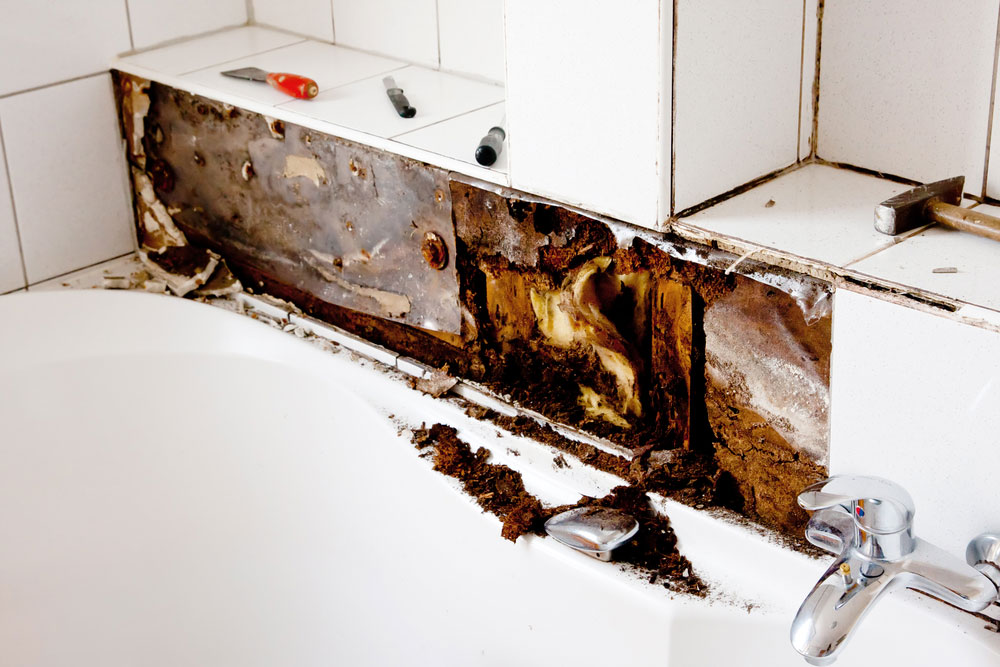Searching for Signs of Water Damage in the Bathroom
Searching for Signs of Water Damage in the Bathroom
Blog Article
This post in the next paragraphs involving How to Prevent Bathroom Water Damage is without a doubt fascinating. You should keep reading.

The restroom is exceptionally susceptible for wet build-up and also prospective water damages due to the constant use of water in it. This post supplies easy examination techniques to assist identifying water damages risks.
The constant use water in the restroom makes it very at risk for moist build-up as well as possible water damages. By inspecting it frequently, you can lower water relevant damages.
The following set of evaluations is simple to do and also need to be done as soon as in every three months in order to keep your bathroom in good shape as well as to avoid prospective water problems triggered by the bath tub, the shower, pipeline joints and also plumbing, sinks, closets, and also the commode
Do not forget performing these examinations and also be thorough while performing them. Keep in mind that these straightforward examinations can conserve you a great deal of cash by giving very early signs for water damages
Bath tub as well as Shower
The shower as well as tub need special attention and maintenance. Check the floor tiles and also change if split. Make certain that there is no missing out on grout between the tiles. Inspect and also change split caulking at joints where the walls meet the floor or the bath tub. Obstructed drains pipes as well as pipes problems will certainly stop the tub from drying and also might suggest major problems under the bath tub. Talk to a professional immediately to avoid structural damages. Take notice of discolorations or soft areas around the bath tub wall surfaces as they may indicate an inner leakage.
Plumbing
Signs for water damage are tough to find because most pipelines are mounted inside the wall surfaces.
Pay unique interest to flooring and also wall surfaces moisture and also spots as they may show an undetectable plumbing issue. Examine wetness levels in adjacent spaces too.
Sinks as well as Cabinets
Sinks and closets are subjected to dampness as well as humidity day-to-day as well as are often ignored. Examine consistently under the sink as well as on the kitchen counter above it. Fix any type of drip in the catch as it may recommend drain issues. Look around the sink, slow-moving draining pipes might indicate an obstructed drain. Change sink seals if they are cracked or loose.
The Commode
The bathroom is an at risk water junction. Inspect the water lines and search for leakages around the toilet seat, in the tube, and under the water storage tank. If you detect any type of signs of wetness on the flooring around the toilet, look for leakages in the toilet rim and also storage tank seals.
Be aware that hanging bathroom dish deodorants boosts the opportunities for clogs.
10 TIPS TO PREVENT WATER DAMAGE IN THE BATHROOM
The average household uses approximately 80-100 gallons of water per person per day. For a family of 4, that's almost 2,500 gallons of water a week! The largest portion of this consumption comes from bathroom use. Flushing the toilet uses the most water, followed by taking a shower or bath. With that much water running through the home, water damage in the bathroom is bound to happen. Knowing how to spot signs of a water leak is essential to preventing long-term damage. This guide provides you with tips to reduce the impact of water damage on your bathroom.
CAUSES OF BATHROOM WATER DAMAGE
Pipe breaks are the most common cause of water damage we see in our daily jobs. The age of a pipe plays a large role in a pipe break as well as corrosion. Over time, the metal begins to break down, allowing water to escape. Frozen pipe breaks are also a concern in the winter months. Toilet overflows caused by paper products or children flushing inappropriate items. Degraded caulking around the toilet or bathtub can allow water seepage, sometimes behind the fixture, into the subfloor or walls. Condensation forms when the water in a pipe is cooler than the air temperature. Beads of water form on the exterior of the pipes, sometimes so much so that the water begins to drip and pool below. Sink or shower backups created by poor drainage. HOW TO PREVENT WATER DAMAGE IN YOUR BATHROOM
Inspect your toilet supply line for worn or frayed hoses and replace them as needed. Winterize your plumbing to prevent a frozen pipe break. Use vent fans to prevent condensation that can lead to mold growth. Routinely check and replace degraded caulking around your toilet or bathtub. Increase the temperature in your toilet tank and insulate your pipes during the warm summer months to keep condensation from forming. Use child safety locks on the toilets. Flush only toilet paper. "Flushable" wet wipes are actually not good for your plumbing system. Additionally, feminine hygiene products should not be flushed. Prevent water from escaping the tub or shower. Make sure shower curtains are in good condition. Inspect shower doors and replace the seal strip if necessary. Wipe up any water that accumulates on the floor and use bath mats. Water left to sit can cause damage to the tiles and flooring. Refrain from using bath products containing heavy oils to avoid a clogged drain.

We were brought to that write-up on Common Causes of Water Damage in a Bathroom through a friend on our other web blog. Be sure to take the time to distribute this content if you enjoyed reading it. Bless you for your time. Visit us again soon.
Schedule Free Estimate Report this page